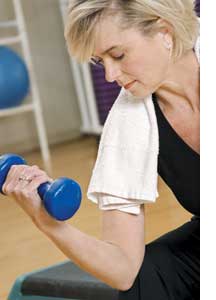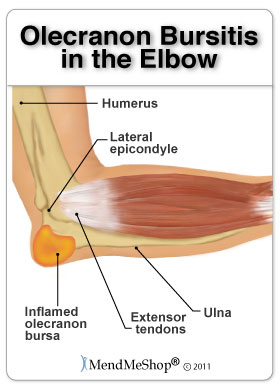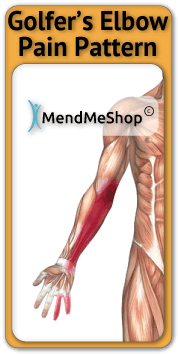Golfers Elbow is one of the most popular forms of acute tendonitis and is most prevalent in females. Elbow injuries account for 35% to 33% of all injuries in amateur golfers. Golfers Elbow is a very painful condition affecting the inside of the elbow (close to the "funny bone") and results from overuse of arm and forearm muscles, or hitting an obstruction (ground, root, etc) instead of the golf ball during a hard swing.
Our elbow is very simple yet so important to the overall use of our whole arm and shoulder. It is a complex system of bones, muscles, nerves and tendons. The elbow joint gives use the ability to lift with strength, climb trees and build our modern world. It is so unique that the joint allows the muscles in the forearm rotate when we twist our wrist. The tissue is strength yet delicate at the same time.
If you are experiencing any of the above symptoms or you're suffering from on-going pain on the inner part of your elbow then you might have a golfers elbow injury.
It is a form of chronic degeneration of the tendon called tendinosis. There won't be much swelling but significant tenderness on and around the tendons that attach to the small bony part on the inside of your elbow (medial epicondyle).
Golfers Elbow is commonly caused from the overuse of the tendons and muscles located in your forearm (brachialis, brachioradialis, pronator teres and flexor carpi radialis). The group of muscle and tendons in your arm and elbow help to close (pronate) your wrist and fingers. The wear and tear on these tendons is a result of small tears in your tissue that don't heal properly.
Anyone can suffer from golfers elbow, a job that has you using your hands, wrists and fingers doing a repetitive action, increases the stress on the tissue. Jobs may include; mechanic, lab technicians, hygienists, plaster, painter, pitcher, gardener or carpenter. Sporting activities include; video games, baseball, tennis, racketball and bowling.
Golfer's Elbow is most often a result of forceful contractions and overuse, such as pushing down while using a screwdriver. Vigorous use and movements or overstraining of the forearm muscles that move your fingers, hand, wrist and forearm. The tendons and muscles are pushed and pulled with such forces that tiny tears form in the tissue and scar tissue and/or calcium deposits form. The growth of scar tissue will put pressure on your soft tissue and nerves, and interrupt the blood flow to this area; this can be very painful

If golfers elbow pain is due to a deterioration of the tendon (tendinopathy), it can take from two to six months to fully recover. Many cases of golfers elbow become chronic problems that progressively get worse if the sufferer continues performing the causal activity that started the condition in the first place. When you do this, your body telling you there is a problem as the area will continue to generate a lot of pain.
Chronic Golfers Elbow: Tendinosis will get worse over time if not dealt with correctly or quickly. The inability to heal the tendinosis will cause it to keep coming back or last months or even years. The main long-term problem associated with golfers elbow is failed healing, not inflammation. If you cannot rest the elbow from the activity that started it in the first place, then you will have little to no chance of healing this chronic injury. Eventually you risk the event of a complete tendon rupture which would only be fixable through reattachment surgery (and possible debridement and grafting).

Acute elbow tendonitis: An acute injury may be caused from a weekend re-roofing your house or putting in a new flowerbed. Most times we push our bodies too much too soon before properly warming-up that area. Repetitive use of the elbow over time causes small tears in the tissue with not enough time to heal in between (degenerative). The best way to heal an acute injury is with simple conservative treatments - rest, cold and Circulation Boost with an Elbow TShellz Wrap®.
Visiting your doctor when you have elbow pain is always recommended, as there are many possible issues that can happen within the arm and elbow. Sometimes, one set of symptoms can result in multiple diagnoses. Golfers elbow is sometimes misdiagnosed as bursitis or arthritis. A few conditions that may show symptoms similar to Golfer's Elbow are as follows..
The closer the bursa is to the surface of the skin, the more likely the chance of infection from specific bacteria that are commonly found on the surface of the skin. This bacterial infection is known as septic bursitis and it is caused by the Staphylococcus Epidermis (or Staphylococcus Aureus) bacteria. Septic Bursitis occurs most commonly in men (85% of all cases occur in men) and you are at higher risk of contracting this if you:

Some people with diseases such as rheumatoid arthritis, gout or scleroderma may contract bursitis from crystalline deposits in the joints. Although not much is known about how this process happens, it is common knowledge that Uric acid is a normal byproduct of daily metabolism. If you are diagnosed with gout then you are unable to break down this uric acid properly, leading to crystallization of this excess acid which deposits in joints, a painful symptom that can often lead to bursitis.
Tennis Elbow is signified by pain will be felt around the bony , outside part of the elbow. With golfer's elbow, pain will be felt on the inside of the elbow. The tendons attached to the bone at your elbow are connected to muscles in your forearm, which is why these injuries will sometimes cause pain in your forearm. These injuries are usually caused by racquet sports, golf and overuse from gardening and repetitive movements of your hand or wrist (ie. using a screwdriver).
As stated earlier, symptoms of golfer's elbow include:

In the beginning (before the injury becomes chronic), this pain will often go away within 24 hours after an activity. However if not dealt with immediately, your pain and stiffness will get worse over weeks or months, to the point where you may feel soreness even when your arm is still. You can also experience a severe burning pain and atrophied forearm muscles (loss of muscle mass), which results in a weakened grip. If left untreated, you may experience extreme loss of motion and function of your elbow and forearm.
The best way to diagnose this condition is with a quick visit to the your doctor for a physical examination of your elbow, arm and wrist. The doctor will be looking for tenderness on the inside of your arm.
Range of motion movements / tests, will be done to see how much movement has been lost in the elbow and arm. Your elbow might hurt from the doctor poking and prodding at it, but by doing this the doctor will know for sure the source of your pain, the level of tenderness in and around your elbow and how well your elbow can move with this condition.
Your doctor may also consider any previous elbow injuries or joint stiffness that you may have had in the past. This will help the doctor to determine if you have a more complex injury in your elbow and rule out any other elbow injuries that may be present.
An X-ray of the elbow will provide clarification if you are suffering from a bone related condition such as arthritis, gout or a fracture to any bone in your elbow.
Other tests like a bone scan, MRI (magnetic resonance imaging) or blood tests may be done if an x-ray looks normal or the doctor is unsure whether you have a fracture. These tests will also rule out any infections of the bone or tissue.

Tendonosis is a noninflammatory, degenerative condition of the collagen fibers in the tendon often caused by repetitive stress injury of the tendon fibers. As the collagen breaks down, the typically straight and flexible fibers become a tangled mess with little pockets of jelly.
Tendonosis is caused by repetitive motion which causes an accumulation of microinjuries. The tendon tries to repair itself but eventually the breakdown of the collagen fibers exceeds the repair speed and the new collagen is produced with an abnormal structure and composition.

Unlike tendonitis, there are no inflammatory tissues with a tendonosis injury making it hard to diagnose visually as there are no visible symptoms such as swelling, heat and redness. However, both injuries cause pain, tenderness and stiffness of the joints.
If not treated correctly the tendon will continue to degenerate causing further injury.
The good news is that most cases of golfer's elbow will heal with simple home conservative treatments and surgery is often not needed! It's generally understood by doctors and surgeons, that surgery will introduce more scar tissue into the elbow. This added scar tissue will be problematic, requiring visits to the clinic and conservative treatment options post-surgery. This is why surgery is only performed as a last resort for chronic elbow injuries or a fractured bone that won't heal with conservative treatment methods.
Some conservative treatment methods recommended include:
For acute (new or recent) elbow injuries that have the ability to heal on their own - your doctor may even suggest use of a removable sling. This can be helpful to prepare you for visits to the PT clinic and mobility exercises.
However, prolonged use of a sling or long-term rest (restricted movement) without proper exercise or stretching can make your elbow condition worse (and also affect shoulder mobility). If your arm remains completely immobilized and at constant rest, the edges of your soft tissue tear will begin to fill in with scar tissue as part of the healing process. You may also have on-going symptoms of pain, swelling, inflammation, and even poor blood flow circulation.
To learn more about Golfer's Elbow Treatments, please go to our golfer's elbow website here.
Product Advisors are available 9:00 am to 5:00 pm Eastern Standard Time Monday to Friday.
I want to learn more about Post-Surgery Recovery
I want to learn more about TShellz Wrap® Circulatory Boost
I want to learn more about Ice & Heat: Which Is Better For Treatment?
I want to learn more about Tendonitis Treatments
I want to learn more about Tendonitis Surgery
During your recovery, you will probably have to modify and/or eliminate any activities that cause pain or discomfort at the location of your soft tissue injury until the pain and inflammation settle. The more diligent you are with your treatment and rehabilitation, the faster you will see successful results!
Please be aware that this information is neither intended nor implied to be a substitute for professional medical advice. CALL YOUR HEALTHCARE PROVIDER IMMEDIATELY IF YOU THINK YOU MAY HAVE A MEDICAL EMERGENCY. Always seek the advice of your physician or other qualified health provider before using any of our outstanding products to make sure they are right for you and your condition or if you have any questions regarding a medical condition. Always see your doctor for a proper diagnosis as there are often many injuries and conditions (some very serious) that could be the cause of your pain.
© 2025 In.Genu Design Group, Inc. Contact Us